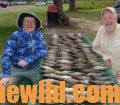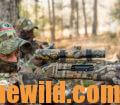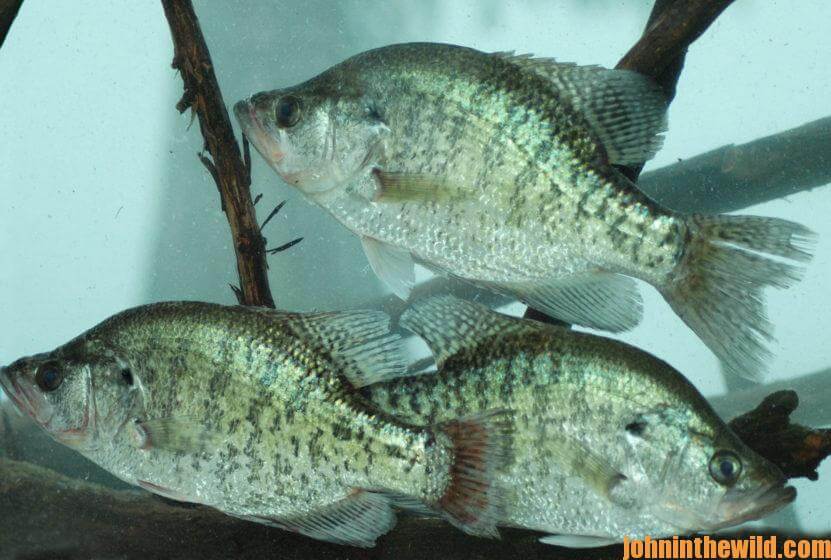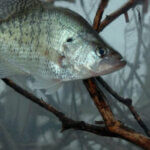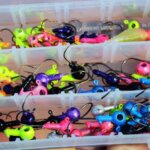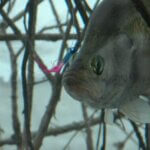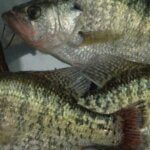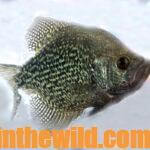Editor’s Note: The most-dependable place to find and catch crappie throughout the spring is locations where the prespawn crappie hold before going to the bank, since crappie don’t all go to the banks at the same time. Nor do they spawn-out all their eggs the first time they move to the banks. A crappie may go to the bank to spawn several times during the spring and then return to its prespawn spots before going back to shallow water to spawn. The crappie also move to prespawn sites to hold before they move offshore to deeper water. Let’s look at where some of the best crappie-fishing guides look for and catch prespawn crappie.
According to Adams, “The middle prespawn occurs when the crappie move-out of the mouths of the creeks and start moving- up the creeks toward the spawning areas. The crappie will be holding on structure, the edges of grass or on drop-offs on the creek ledges in water 8-15 foot 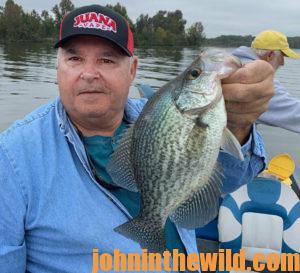 deep. On a warm day, the crappie may suspend in 5-6-foot deep water over the structure, the drop-off or the grass. On cloudy, overcast days, the crappie may be concentrating at 8-10 foot deep above the structure. During the middle of the prespawn, I’ll generally fish a tight line with minnows. Or, I’ll cast a jig out and reel it very slowly, pause it, let it fall and then start my retrieve again. Most of the strikes for these prespawn crappie will come when I pause the jig and let it fall. Sometimes I’ll lift my rod tip up and then drop the rod tip quickly and continue to reel. At times the crappie prefer a slow, steady retrieve.”
deep. On a warm day, the crappie may suspend in 5-6-foot deep water over the structure, the drop-off or the grass. On cloudy, overcast days, the crappie may be concentrating at 8-10 foot deep above the structure. During the middle of the prespawn, I’ll generally fish a tight line with minnows. Or, I’ll cast a jig out and reel it very slowly, pause it, let it fall and then start my retrieve again. Most of the strikes for these prespawn crappie will come when I pause the jig and let it fall. Sometimes I’ll lift my rod tip up and then drop the rod tip quickly and continue to reel. At times the crappie prefer a slow, steady retrieve.”
Adams mentions that black, white and black-nosed crappie live in Lake Eufaula. “Out of 50 crappie you’ll catch, you’ll probably only catch one black-nosed crappie. A party of two people should be able to limit out on prespawn crappie (30 per day per person), if the weather’s good. One of the big advantages for great crappie fishing that we have here at Lake Eufaula is due to the lake’s healthy bass population and numbers of bass weighing 5-pounds or more. At a collegiate bassing tournament held a couple of weeks ago in early February at Eufaula, the team who won weighed in five bass weighing 29.98 pounds. Because the lake has so many bass fishermen, the crappie on the lake are somewhat neglected and don’t receive near the crappie-fishing pressure that crappie on many other lakes do.
“Something that I do is every year I sink brush to take advantage of the three prespawn water depths where crappie tend to hold. I’ll usually sink brush in the mouths of creeks to attract crappie in the early prespawn. Next I’ll sink brush on ledges and drop-offs in the creeks. Then I’ll also sink structure on the spawning flats, perhaps in 10-12 foot deep water, for the late prespawn. Then I can follow the crappie prespawn migration pattern from the mouths of creeks to the ledges and then to spawning flats.
“On the ledges where the crappie generally hold in the middle prespawn, I like to sink Christmas trees in concrete blocks and cut out some of the limbs in the middles and the tops of those Christmas trees where crappie can hold and ambush bait. I may put 6-10 Christmas trees like this in one spot. I’ll put concrete inside the holes in the concrete blocks, tie a line from each concrete block to the base of a Christmas tree and tie on a 2-liter jug in the top of the Christmas tree to hold it erect. When current starts coming through the lake, my Christmas tree will move with the current and usually not tip over. After the Christmas tree becomes waterlogged and falls down, it will lay on the edge of a drop-off and continue to hold crappie – either when they’re going-to or coming- away from the spawning beds.
“Once the crappie move to the spawning flats, I’ll put out 5-gallon buckets with 60 pounds of concrete in each and river cane or crepe myrtle branches placed upright in the concrete. If the spawning flats are in 12-foot-deep water, I’ll have the tops of the river cane or the crepe myrtle limbs situated, so that they’re 6 feet under the water.”
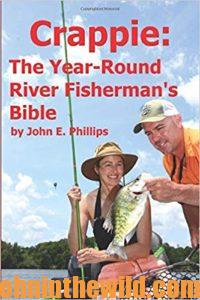 To learn more about crappie fishing, check out John E. Phillips’ book, “Crappie: The Year-Round River Fisherman’s Bible” at https://amzn.to/2mxWIt4, available in Kindle and print versions and in Audible at https://adbl.co/382m0SR.
To learn more about crappie fishing, check out John E. Phillips’ book, “Crappie: The Year-Round River Fisherman’s Bible” at https://amzn.to/2mxWIt4, available in Kindle and print versions and in Audible at https://adbl.co/382m0SR.

